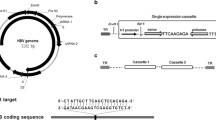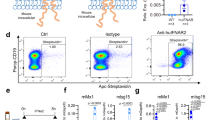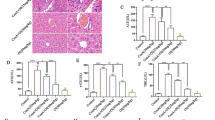Abstract
Background
B cell-activating transcription factor (BATF) contributes to Th17 cell differentiation and pathological inflammatory responses.
Aims
This study explored BATF as a regulator of Th17 differentiation in normal and hepatitis B virus (HBV) transgenic mice.
Methods
Normal mice were divided into control, short hairpin RNA (shRNA) scramble, and shRNA BATF groups. HBV transgenic mice were divided into control, entecavir, shRNA scramble, entecavir + vector control, entecavir + shRNA scramble, shRNA BATF, and entecavir + shRNA BATF groups. Serum concentrations of AST, ALT, HBV-DNA, BATF, IL-17, and IL-22 and Th17 cell frequencies in the liver were compared among the groups. Correlations of serum HBV surface antigen (HBsAg), e-antigen (HBeAg), and core antigen (HBcAg) concentrations with BATF mRNA expression and the proportion of Th17 cells in the livers of HBV transgenic mice were also analyzed.
Results
Serum AST, ALT, BATF, IL-17, and IL-22 concentrations and Th17 cell proportions were higher in HBV transgenic mice relative to normal controls. Positive correlations of the HBcAg concentration with BATF mRNA and the proportion of Th17 cells were observed in HBV transgenic mice. BATF interference reduced the proportion of Th17 cells and serum IL-17 and IL-22 concentrations and led to obvious downregulation of AST, ALT, BATF, IL-17, and IL-22 expression and a reduced proportion of Th17 cells when combined with entecavir.
Conclusion
HBV markedly upregulated BATF expression and promoted Th17 cell activation. By contrast, BATF interference significantly impeded the proliferation of Th17 cells and secretion of IL-17 and IL-22 while alleviating hepatic lesions.


Similar content being viewed by others
References
Seeger C, Mason WS. Hepatitis B virus biology. Microbiol Mol Biol Rev. 2000;64:51–68.
Cui Y, Jia J. Update on epidemiology of hepatitis B and C in China. J Gastroenterol Hepatol. 2013;28:7–10.
Yang S, Yu C, Chen P, et al. Protective immune barrier against hepatitis B is needed in individuals born before infant HBV vaccination program in China. Sci Rep. 2015;5:18334.
Zhao RR, Yang XF, Dong J, et al. Toll-like receptor 2 promotes T helper 17 cells response in hepatitis B virus infection. Int J Clin Exp Med. 2015;8:7315–7323.
Ge J, Wang K, Meng QH, Qi ZX, Meng FL, Fan YC. Implication of Th17 and Th1 cells in patients with chronic active hepatitis B. J Clin Immunol. 2010;30:60–67.
Williams KL, Nanda I, Lyons GE, et al. Characterization of murine BATF: a negative regulator of activator protein-1 activity in the thymus. Eur J Immunol. 2001;31:1620–1627.
Martinez GJ, Dong C. BATF: bringing (in) another Th17-regulating factor. J Mol Cell Biol. 2009;1:66–68.
Miao T, Raymond M, Bhullar P, et al. Early growth response gene-2 controls IL-17 expression and Th17 differentiation by negatively regulating Batf. J Immunol. 2013;190:58–65.
Zhang Z, Pan Q, Duan XY, et al. Fatty liver reduces hepatitis B virus replication in a genotype B hepatitis B virus transgenic mice model. J Gastroenterol Hepatol. 2012;27:1858–1864.
Guidotti LG, Matzke B, Schaller H, Chisari FV. High-level hepatitis B virus replication in transgenic mice. J Virol. 1995;69:6158–6169.
Pan CQ, Zhang JX. Natural history and clinical consequences of hepatitis B virus infection. Int J Med Sci. 2005;2:36–40.
Te HS, Jensen DM. Epidemiology of hepatitis B and C viruses: a global overview. Clin Liver Dis. 2010;14:1–21.
Butt AA. Hepatitis C virus infection: the new global epidemic. Expert Rev Anti Infect Ther. 2005;3:241–249.
Yu R, Fan R, Hou J. Chronic hepatitis B virus infection: epidemiology, prevention, and treatment in China. Front Med. 2014;8:135–144.
Yan YP, Su HX, Ji ZH, Shao ZJ, Pu ZS. Epidemiology of hepatitis B virus infection in China: current status and challenges. J Clin Transl Hepatol. 2014;2:15–22.
Busca A, Kumar A. Innate immune responses in hepatitis B virus (HBV) infection. Virol J. 2014;11:22.
Yousfi N, Hattaf K, Tridane A. Modeling the adaptive immune response in HBV infection. J Math Biol. 2011;63:933–957.
Park H, Li Z, Yang XO, et al. A distinct lineage of CD4 T cells regulates tissue inflammation by producing interleukin 17. Nat Immunol. 2005;6:1133–1141.
Zhang Z, Zhang JY, Wang LF, Wang FS. Immunopathogenesis and prognostic immune markers of chronic hepatitis B virus infection. J Gastroenterol Hepatol. 2012;27:223–230.
Ouyang W, Kolls JK, Zheng Y. The biological functions of T helper 17 cell effector cytokines in inflammation. Immunity. 2008;28:454–467.
Zhang JY, Zhang Z, Lin F, et al. Interleukin-17-producing CD4(+) T cells increase with severity of liver damage in patients with chronic hepatitis B. Hepatology. 2010;51:81–91.
Meng F, Wang K, Aoyama T, et al. Interleukin-17 signaling in inflammatory, Kupffer cells, and hepatic stellate cells exacerbates liver fibrosis in mice. Gastroenterology. 2012;143:e761–e763.
Wang B, Zhao XP, Fan YC, Zhang JJ, Zhao J, Wang K. IL-17A but not IL-22 suppresses the replication of hepatitis B virus mediated by over-expression of MxA and OAS mRNA in the HepG2.2.15 cell line. Antiviral Res. 2013;97:285–292.
Kurachi M, Barnitz RA, Yosef N, et al. The transcription factor BATF operates as an essential differentiation checkpoint in early effector CD8+T cells. Nat Immunol. 2014;15:373–383.
Dunsford HA, Sell S, Chisari FV. Hepatocarcinogenesis due to chronic liver cell injury in hepatitis B virus transgenic mice. Cancer Res. 1990;50:3400–3407.
Galli A, Ceni E, Mello T, et al. Thiazolidinediones inhibit hepatocarcinogenesis in hepatitis B virus-transgenic mice by peroxisome proliferator-activated receptor gamma-independent regulation of nucleophosmin. Hepatology. 2010;52:493–505.
Feng H, Yin J, Han YP, et al. Regulatory T cells and IL-17(+) T helper cells enhanced in patients with chronic hepatitis B virus infection. Int J Clin Exp Med. 2015;8:8674–8685.
Zhang JY, Song CH, Shi F, Zhang Z, Fu JL, Wang FS. Decreased ratio of Treg cells to Th17 cells correlates with HBV DNA suppression in chronic hepatitis B patients undergoing entecavir treatment. PLoS ONE. 2010;5:e13869.
Meyer NP, Johansen LM, Tae HJ, Budde PP, Williams KL, Taparowsky EJ. Genomic organization of human B-ATF, a target for regulation by EBV and HTLV-1. Mamm Genome. 1998;9:849–852.
Grusdat M, McIlwain DR, Xu HC, et al. IRF4 and BATF are critical for CD8(+) T-cell function following infection with LCMV. Cell Death Differ. 2014;21:1050–1060.
Tian ZF, You ZL, Yi H, Kuang XM, Wang YM. Effect of entecavir on CD4+T-cell subpopulations in patients with chronic hepatitis B. Ann Hepatol. 2016;15:174–182.
Niu YH, Yin DL, Liu HL, et al. Restoring the Treg cell to Th17 cell ratio may alleviate HBV-related acute-on-chronic liver failure. World J Gastroenterol. 2013;19:4146–4154.
Funding
This work was supported by the grants from National Natural Science Foundation of China (81171579, 81201287, 81300318, and 81371832), Key Project of Chinese Ministry of Science and Technology (2012ZX10002007 and 2013ZX10002001), and Science and Technology Development Plan of Shandong Province (2014GSF118068).
Author information
Authors and Affiliations
Corresponding author
Ethics declarations
Conflict of interest
The authors declare that they have no conflict of interest.
Ethical approval
All mouse experiments were approved by the Institutional Animal Care and Use Committee (KYLL-2017(KS)-076).
Rights and permissions
About this article
Cite this article
Chen, LY., Fan, XP., Fan, YC. et al. BATF Interference Blocks Th17 Cell Differentiation and Inflammatory Response in Hepatitis B Virus Transgenic Mice. Dig Dis Sci 64, 773–780 (2019). https://doi.org/10.1007/s10620-018-5392-x
Received:
Accepted:
Published:
Issue Date:
DOI: https://doi.org/10.1007/s10620-018-5392-x




